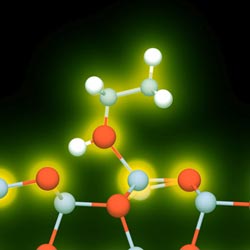Livermore researchers develop battery-less chemical detector

A battery-less chemical sensor relies on dynamic interactions of molecules with semiconductor nanowire surfaces that can induce electrical voltages between segments of nanowires.<br>
The device overcomes the power requirement of traditional sensors and is simple, highly sensitive and can detect various molecules quickly. Its development could be the first step in making an easily deployable chemical sensor for the battlefield.
The Lab's Yinmin “Morris” Wang and colleagues Daniel Aberg, Paul Erhart, Nipun Misra, Aleksandr Noy and Alex Hamza, along with collaborators from the University of Shanghai for Science and Technology, have fabricated the first-generation battery-less detectors that use one-dimensional semiconductor nanowires.
The nanosensors take advantage of a unique interaction between chemical species and semiconductor nanowire surfaces that stimulate an electrical charge between the two ends of nanowires or between the exposed and unexposed nanowires.
The group tested the battery-less sensors with different types of platforms – zinc-oxide and silicon — using ethanol solvent as a testing agent.
In the zinc-oxide sensor the team found there was a change in the electric voltage between the two ends of nanowires when a small amount of ethanol was placed on the detector.
The sensor part of the device is about 2 millimeters in size.
“The rise of the electric signal is almost instantaneous and decays slowly as the ethanol evaporates,” Wang said.
However, when the team placed a small amount of a hexane solvent on the device, little electric voltage was seen, “indicating that the nanosensor selectively responds to different types of solvent molecules,” Wang said.
The team used more than 15 different types of organic solvents and saw different voltages for each solvent. “This trait makes it possible for our nanosensors to detect different types of chemical species and their concentration levels,” Wang said.
The response to different solvents was somewhat similar when the team tested the silicon nanosensors. However, the voltage decay as the solvent evaporated was drastically different from the zinc-oxide sensors. “The results indicate that it is possible to extend the battery-less sensing platform to randomly aligned semiconductor nanowire systems,” Wang said.
The team's next step is to test the sensors with more complex molecules such as those from explosives and biological systems.
The research appears on the inside front cover of the Jan. 4 issue of Advanced Materials.
Founded in 1952, Lawrence Livermore National Laboratory is a national security laboratory, with a mission to ensure national security and apply science and technology to the important issues of our time. Lawrence Livermore National Laboratory is managed by Lawrence Livermore National Security, LLC for the U.S. Department of Energy's National Nuclear Security Administration.
Media Contact
All latest news from the category: Power and Electrical Engineering
This topic covers issues related to energy generation, conversion, transportation and consumption and how the industry is addressing the challenge of energy efficiency in general.
innovations-report provides in-depth and informative reports and articles on subjects ranging from wind energy, fuel cell technology, solar energy, geothermal energy, petroleum, gas, nuclear engineering, alternative energy and energy efficiency to fusion, hydrogen and superconductor technologies.
Newest articles

A universal framework for spatial biology
SpatialData is a freely accessible tool to unify and integrate data from different omics technologies accounting for spatial information, which can provide holistic insights into health and disease. Biological processes…

How complex biological processes arise
A $20 million grant from the U.S. National Science Foundation (NSF) will support the establishment and operation of the National Synthesis Center for Emergence in the Molecular and Cellular Sciences (NCEMS) at…

Airborne single-photon lidar system achieves high-resolution 3D imaging
Compact, low-power system opens doors for photon-efficient drone and satellite-based environmental monitoring and mapping. Researchers have developed a compact and lightweight single-photon airborne lidar system that can acquire high-resolution 3D…





















